
There was a flea market for children on a square near here on Saturday. My boy sold a pile of toys and earned 300 kroner towards the Lego City Police Headquarters he's saving up for. Here's some photos that show cargo bikes in their natural environment. This is the spiritual home of cargo bikes , after all.
How to Transport your goods to the flea market
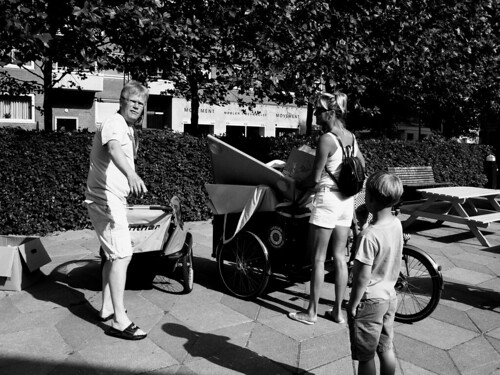
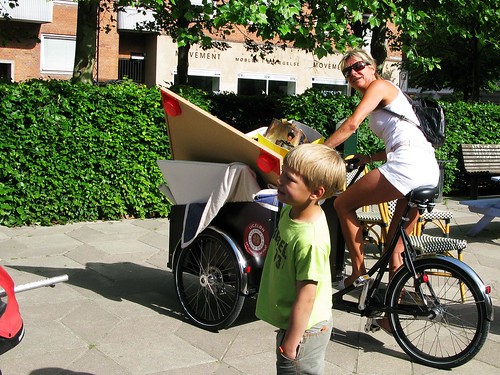
How to shop at the flea market
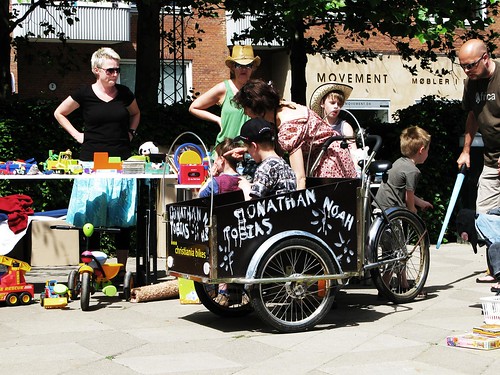
How to get stuff home from the flea market.
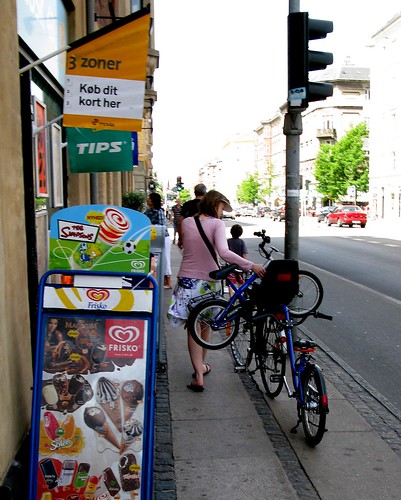

Saw this today. Just great.
The person who owns the bike has a wardrobe and and two night tables that they want to offload. What better way to advertise than to put a couple of signs on your bike basket. Your bike will be riding all over the city each and every day anyway, so you'll be seen. I saw it outside a supermarket. Caught my eye right away.
Advertising. Copenhagen style.
I was sent this today and I can only say that it is absolutely brilliant. It's an hour-long filmed seminar with legendary John Pucher at Simon Fraser University in Vancouver, Canada.
I've read most of what's he has written on increasing cycling and making cycling accessible but seeing this seminar online is purely inspirational.
Now it's no secret that segregated bike infrastructure is the only way ahead for cities wishing to increase their bike culture and daily percentage of trips made by bike. There is no alternative to this common sense.
Seeing John Pucher summing everything up in one entertaining, informative and inspiring video has made my day. He highlights the experiences of many European cities and debunks many myths along the way.
See the film now. Quickly. It's wonderful.
More on John Pucher:
- Momentum Planet's interview with The Bicycle Scholar
- His homepage at Rutgers with links to his publications.
UPDATE:
The Dreams on Wheels exhibition has morphed into v.2.0 and is now showing around the world. Well... not NOW, but all through 2009.
First stop: Edinburgh.
Showing at the Royal Botanical Gardens from the 24 January to 21 March 2009.
Read this article/interview from the Sydney Morning Herald for more info.
Copenhagenize and Copenhagen Cycle Chic are pleased to be included in a travelling exhibition about Danish bike culture which opened in Canberra, Australia earlier this year.
Dreams on Wheels is curated by Thomas Ermacora, founder of Etikstudio, for the Danish Foreign Ministry and is scheduled to travel to many cities around the world between now and the UN Climate Change Conference in Copenhagen next year, called COP15. The show in Canberra accompanies the reopening of the Danish Embassy in the Australian capital.
A Copenhagen City Bike and my posters behind it, taken by a local.
An earlier incarnation of the exhibition was shown at the Danish House in Paris, The Danish Design Centre in Copenhagen and the Harbourfront Centre in Toronto.
The concept is driven by the motivation to illustrate how a “cyclocentric” approach to urban development stimulates environmental concern and sustainable civic behaviour.
Admission is free and open to people of all ages. Here's the website, from the Danish Embassy.
There is a great programme, including cycle films and speakers.
20 Danish bike brands are represented, from Biomega to Velorbis and you can try a Copenhagen City Bike. Jan Gehl, the urban planner, and his company Gehl Architects are represented and you can also learn about cycling life in other Danish cities.
The exhibition will be cloned and presented in various other cities simultaneously, starting with Australian cities this summer [their winter]. I'll keep you updated as to where the show is heading.
Here's a note from one of our readers who saw it:
"Fantastic exhibition. Canberra's a good cycling town, too, but nothing like Copenhagen!
The funny thing, though, is that the exhibition is right on the route I take along the lake to get to and from my partner's place. The night it opened, I was cruising along the bike path, and found that it was completely blocked by a great big marquee, and heaps of people drinking champagne. I was outraged that some bastards were blocking the path, and wondered who would make cycling so difficult. I dismounted to walk my bike through the crowds, and soon realised that it was an exhibition promoting cycling! Classic."
DESIGN LAB
While we're at it, there are some new t-shirt designs over at the online boutique:
One of our readers from Vancouver sent a mail asking about how we Copenhageners park our bikes outside our homes.
Most buildings have bike sheds in the back yard where residents can park their bikes. Here at our place we have four bike sheds for about 40 flats. We have easy access from the backyard to the street.
There are, however, many flats where getting from the backyard to the street takes time. Even just a couple of minutes is a frustration. Copenhageners want the quickest possible route from their front door to their bike and then the bike lane.
It's all about ease-of-use. It's irritating if you have to spend too much time getting onto your bike. I'm sure there are people in Copenhagen who keep their fancy specialist bike in their flat, but I don't know any. Your bike is in the shed, the bike room in your cellar or leaning up against something outside your door.
Most people opt for parking their bike along the building, using their kickstands or leaning them against the facade. Chaotic at times but it is the fastest way to get going. Out of the front door, unlock the wheel lock and you're off.
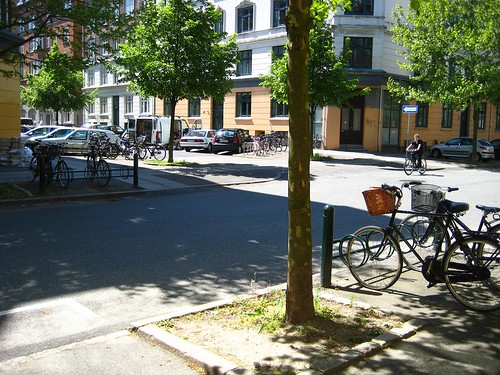
There are also a growing number of bike racks on the streets. This intersection is 50 m from my flat. You can see four bike racks in the shot and there are two more out of frame to the right. They're well used and help keep bikes off the facades.
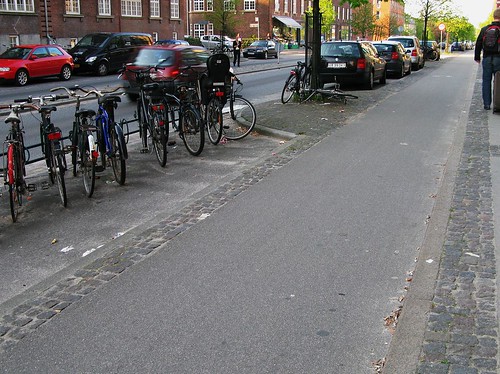
There's a tendency of late to utilize parking spots on the street and place bike racks in their stead. This design idea is a direct response to the habits of the citizens who want, and demand, ease-of-use. Given the fact that bikes in the heart of the city and the surrounding neighbourhoods far outnumber cars, it makes sense. On average, in the neighbourhoods surrounding the city centre, only 30% or so own cars. That statistic is a gold medal on the chest of the city for creating bike lanes and infrastructure over the past 40 years. You simply don't need a car to get around.
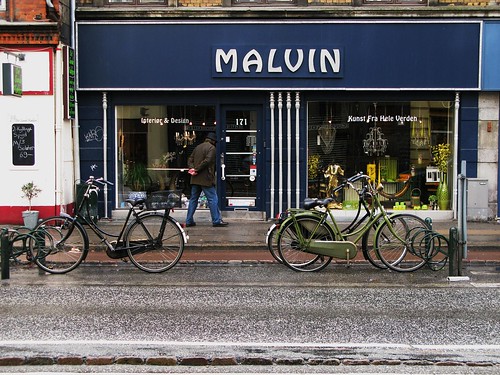
More bike racks in former car parking spots.
I have a set on Flickr with bike racks ad libitum.
And there are a couple of earlier posts on bike racks in Copenhagen. This one and this one .
A handful of the 30,000 daily cyclists on this stretch of bike lane.
Portland deserves a lot of attention for their efforts in building bike infrastructure and generally increasing bike culture in their city. But we were pleased to have New Haven, Conneticut brought to our attention.
The graph above is from the Design New Haven website showing a possible corelation between cycling activity and rising American gas prices. Interesting reading.
For a small city there seems to be a beehive of activity regarding cycling and generally increasing quality of life. They have a 1.8% bike usage rate, which is, in America, very presentable.
Elm City Cycling is a website of local bike advocates.
Bike New Haven is another cycling blog with a fantastic tagline:
"Because cars and poor city planning cannot be the apex of human innovation."
The City government has some info on building bike lanes and greenways on this site.
Momentum Magazine has a feature about the city here.
New Haven! Nice to meet you!
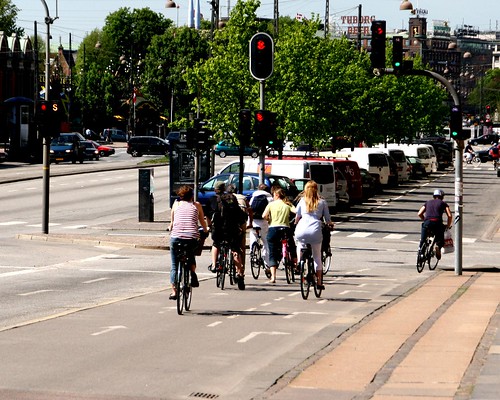
A reader wrote an email regarding a discussion he had on a forum about bike registration. The other chap argued that "if bikes want to use the roads then they should pay for it, just like cars have to." I was asked about bike registration in Europe and my reply became so lengthy that I figured I'd post it here.
Feel free to contribute with other points of view and stats in the Comments section.
This "bikes should pay" argument is not unknown to me but it is, in many ways, a rather weak argument.
Regarding bike registration in Europe, there are half a billion citizens in the European Union alone. 100 million of them ride a bicycle on a daily basis according to the European Cyclists' Federation. None of them are inconvenienced by bicycle registration, least of all the Netherlands or Denmark - the two countries with most bike usage.
Here's three good counter-arguments from my ragged little bag of opinions:
1. Road Usage and Wear and Tear
Firstly, imagine the logistical nightmare of registering tens of millions of bicycles. Firstly you need to pay to develop or adapt a computer system to register them and you need to hire people to run the system to issue registrations and pay for producing licences.
Consider the aforementioned impact on the roads. Your average car in 2005 weighed 1650 kg [3582 lbs]. [source]
My best guess as to the average weight of a bicycle is about 13 kg [30 lbs].
Based on those numbers, a bicycle weighs 0.8% of a car.
You don't need a degree in rocket science to see that the weight impact on the roads made by bicycles is marginal. Let's say a car registration costs $100, based on various factors including wear and tear on the roads. Based on that figure, a bike registration should then cost 80 cents.
Then you'll have to subtract from those 80 cents. In Denmark we have road taxes and environment taxes built into our car registration, not to mention weight taxes, depending on the car's size. A car's environmental impact is far greater, but a bicycle has none. Let's say a 50% reduction in the 80 cents fee for zero environmental impact, just to pick a number.
40 cents per bike. That 40 cents would be reduced to almost nothing after you subtract adminstration fees.
I'm not an economist, but I can already see that the project would not be very profitable. The enforcement issue is another ball of wax. I, for one, would prefer my police force to take care of business more important to society that checking cyclists for registration papers. In short, developing a registration system for bikes would be a monumental waste of taxpayers money and that is in nobody's interest.
Campaigns to increase awareness and safety would be more profitable in the long run.
It is also worthwhile to consider the very simple fact that more bikes with a marginal impact on the roads means less wear and tear. This reduces the necessity for time-consuming and expensive road works to fix the potholes, etc. It will be cheaper for motorists, not to mention much more convenient not having to suffer construction delays.
2. Health Impact
The cyclist, besides having a marginal impact on the roads, will also end up benefiting society on a whole by transporting him or herself by bike. The health benefits are many and they are well-documented. In direct relation to cars, it is interesting to point of some of the many studies regarding pollution.
The level of dangerous, polluting microparticles inside a car are much higher than outside - on a bike, for example. There are a couple of links to earlier posts below regarding this.
Cyclists Can Breathe Easy
Traffic Kills 10 Times More People Than Traffic Accidents
In addition to it being more dangerous to sit inside a car than outside one, consider this excerpt from the above link:
In Denmark almost 4000 people die each year from pollution from cars. That number is ten times higher than those who are killed IN the traffic. According to a recent study, breathing the pollution from the automotive traffic is more dangerous than merely being the traffic.
3400 people die each year from illnesses directly related to the particles released from the exhaust of cars. On top of that there are 200-500 people who die prematurely from heart disease and high blood pressure caused by the noise generated by traffic. Yes... just the NOISE!
I can't even begin to imagine how these numbers will mulitply when applied to any North American city.
So... cyclists are actually reducing health care costs and, in effect, freeing up hospital beds for those who need them. They are also increasing their health levels - which will give them fewer sick days and a more effective working life, thereby contributing more positively to the economy.
There is a study about this in Denmark and here's an excerpt:
- Physically active people live ca. 5 years longer than the physically inactive.
- Physically inactive persons suffer on average for four more years from lengthy illnesses.
- Cycling has the same effect on health as other types of excercise. Four hours of cycling a week, or roughly 10 km a day is a fitting level - luckily for us, this is the average bike usage in Copenhagen - back and forth to work and running errands.
And this:
If Copenhageners rode 10% more kilometres each year:
- This would be an increase of 41 million extra cycling kilometres each year. [At the moment we ride 1.2 million km each day in Copenhagen.]
- The health system would save 59 million DKK per year.
- We would save 155 million DKK in lost production manhours (due to illness)
- There would be 57,000 fewer sick days in the workplace each year. That would be a reduction of 3.3%.
- 61,000 extra life years
- 46,000 fewer years with lengthy illnesses.
3. Get Paid To Ride
All of the common sense above should somehow lead to rewards for cyclists. A city council that builds segregated bike lanes, thereby encouraging citizens to ride, will be spending less on road works and public health.
In Copenhagen we've discovered that:
One extra kilometre of bike lanes on a road:
Building bike lanes on streets with an average of 2,500 bikes and 10,000 cars each day would bring 18-20% more bikes on the stretch of road.
Including a drop of 9-10% in the number of cars and 9-10% fewer accidents and injury.
- A saving of 246,000 DKK in the health sector.
- A saving of of 643,000 DKK in lost production.
- A collective fall in health, production and accident costs each year totalling 633,000 DKK.
- The extra kilometre would give 170,000 more cycle kilometres each year.
- For every 1 krone spent, society would save 5 kroner.
Now THAT is good economics.
In Norway, the Norwegian Public Roads Administration [Vegvesen] actually pays their employees to ride to work instead of driving . Much of the decision is based on the above facts and studies.
"By encouraging people to bike or walk to work we ensure that they get exercise and, at the same time, relieve the pressure on the traffic net" , says District Chief Roar Gartner in Vestfold, Norway.
Summa summarum
If one encounters this odd argument that cyclists should be made to pay for a registration of their vehicle, I hope these offerings above provide a good point of departure for a counter-argument.
Instead of demanding that cyclists pay, motorists should be buying us beer and thanking us on behalf of themselves, their children [present or future], the nation and society in general.
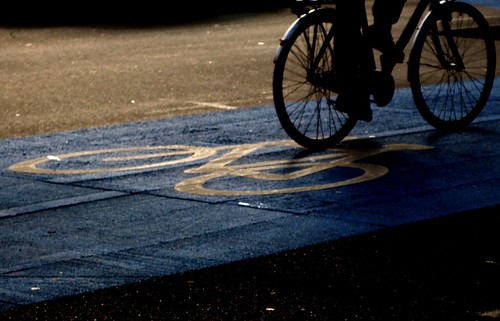
Much is written about the Danish urban planner and architect Jan Gehl with regards to creating segregated bike infrastructure in cities in order to keep cyclists safe and to increase the number of cyclists in the urban landscape.
It's worth mentioning that it's not all about the bike lanes. They are a fantastic symbol of intelligent urban planning, but Gehl's thoughts and experiences with urban planning in general are far-reaching. His consultancy company Gehl Architects continue his important work.
I like this excerpt from an interview with Metropolis Magazine:
"One of the interesting things about Copenhagen is the gradual approach. "Public Spaces, Public Life" is the first ever recording of the life of a city. Every city counts its traffic one or two times a year, but hardly any city knows about what people do in a city and how the city is being used .
"In Copenhagen we've pioneered this as a working method: study what's going on, look at the problems and potentials, improve it, and check it again, so that you can follow the development. Observations like being able to point out that we have four times more public life in Copenhagen after twenty years of work, have been very strong in convincing people about the value of what has been going on. This book demonstrates for the first time the systematic study and recording of the people just as you would cars.
"In my new book "New City Spaces", we describe nine fascinating cities from around the world which have been made much more people-friendly, including: Barcelona; Lyon; Strasbourg; Freiburg, Germany; Portland, USA; Curitiba, Brazil; Cordoba, Argentina; Melbourne and Copenhagen. We talk about how these cities have applied different strategies to make them people-friendly.
"Copenhagen, in this context, is interesting because of the gradual approach. The city has never had a master plan. If city officials did have a master plan that would say for example, "Ten years from now we will have 100,000 square meters of pedestrianized and people-friendly streets, and we will remove 2,000 parking spaces from the downtown area," they would utterly fail in the next election."
And this excerpt about the four types of cities:
"In "New City Spaces", we talk about four types of cities. The first is the "Traditional City" which was built for people moving about on feet and where you still have all the traditional city functions like meeting spaces and marketplaces. You can find this old model in cities like Venice, or in developing countries where cars have not yet penetrated.
"The second type is the "Invaded City". These are old cities where the balances among the various things going on in the city have been upset because everything is now car dominated. We have many of these cities in South and Central America, Europe, Asia, and in many developing countries. They were originally built for another type of city life and people are suffering heavily from this inundation of cars.
"The third city is the "Abandoned City," which is the next step an "Invaded City" goes through. That is when people give up walking and cycling and gradually the whole city fabric becomes adapted to everybody moving in cars: the public life ceases to exist. We have a number of examples in the book. I've seen plenty of examples of this in America, like a city in Mississippi, where there are no sidewalks, and everything happens in the mall or on television. That's why I find a city like Portland interesting, which is at the other end of the same country, and is very much like a European city.
"The fourth type of city, called the "Reconquered City", is included in a chapter called "Winning Back the Public Spaces". It's about a number of inundated or invaded cities which decided that unlimited car traffic is unacceptable, and have turned to improving their cities through public spaces and walking and cycling. We then give examples of reconquered cities--the nine aforementioned cities, and describe specific spaces, streets and squares all over the world that have been interestingly changed or newly built."
I found a great podcast from the City of Sydney featuring a talk with Jan Gehl. Listen to it on this website and hear the man speak.
Here's a good piece from Metropolis Magazine about Copenhagen's 10 Step Program.
While at the Royal Library to see a Sally Mann exhibition I saw Jan Gehl's books in the bookshop. I've heard they sometimes are hard to get a hold of but I've discovered that they are Available from The Danish Architectural Press. In English. They are wonderful sources of inspiration, not just for creating bike lanes and segregated bike infrastructure, but for creating cities worth living in.
Life Between Buildings - Using Public Space
First published in 1971. Currently in its 6th edition.
Public Spaces Public Life
Authors: Jan Gehl, Lars Gemzøe
This book describes the remarkable qualitative inprovements which have taken place in central Copenhagen over the past 34 years, and how they have been accomplished, and is a handbook on how to create human qualities in the city.
New City Spaces
Authors: Jan Gehl, Lars Gemzøe
This book presents an overview of the developments in the use and planning of public spaces, and offers a detailed description of 9 cities and 39 selected public space projects from all parts of the World. The book is extensively illustrated by drawings, plans and photographs.
We've started something cool here...
Here's another cool time lapse commute film, this time from New Zealand. From North Beach to the Central Business District in Christchurch, as sent in by Malcolm. Here's what he wrote:
"Hi Mr Liciousness,
I was in the middle of making my own time lapse movie when I saw your
recent post of something similar in London , and in retrospect your own
from Copenhagen .
So if you ever do another timelapse feature, here's something from down
under, in this case Christchurch, New Zealand. The absence of a time
lapse function on my camera meant I had to record this in real time over
4 days and then speed it up and splice it together.
Despite the flat terrain here in Christchurch, and the popularity of
mountain biking, road racing and triathlon, the cycle commuter is an
endangered species. All of the fleeting glimpses of cyclists in the
video above (except for 1) are school children.
Hopefully some progressive thinking by the council might help to improve
the restrictions, they invited the mighty Jan Gehl to share some of his thoughts recently, so maybe all is not lost ...
Keep up the good work, your blogs keep me dreaming of what we could have
here in our humble city.
Malc"
Cheers, Malcolm! Thanks for sending us the video!
Typical European bikeness, this time from Amsterdam - as seen on my mate Mark's Amsterdamize blog... hmmm wonder where he got the idea for THAT name... :-)
A cool little amusement park ride film from my mate Greg, in Portland. Shocking that they are not wearing helmets, but it looks like fun all the same. :-)
I posted this over at Copenhagen Cycle Chic, but thought I'd include it here, too.
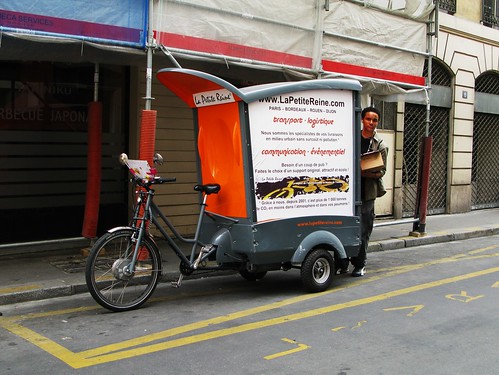
La Petite Reine - the Little Queen - is an affectionate nickname for the bicycle in French. It is also the name of a transport company that uses the cargocycles above throughout Paris.
Wonderful pedal-powered design, although they also have a battery assist for heavy loads and hills. The company also uses Christiania Bikes in their fleet.
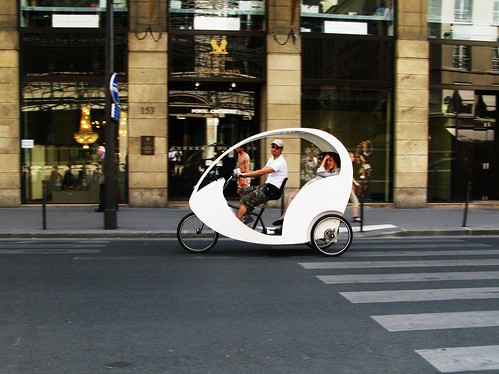
And these bike taxis are also popular on the streets of Paris. Very cool design, as well.
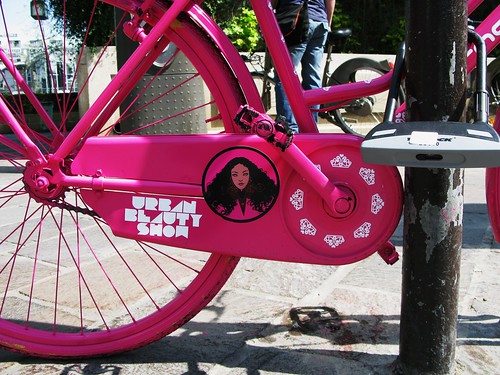
And with the birth of bike culture, advertising changes form, just as we've seen in other European cities here on the blog.
We've got a love-in going on over at Copenhagen Cycle Chic this week. It's La Semaine du Vélib' over there, wherein we celebrate the birth of bike culture in Paris since the introduction of the Vélib' bike share programme last year.
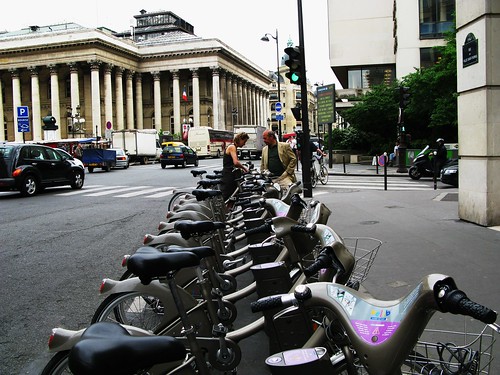
I just spent three days in Paris with Wifealiciousness and two of them were on Vélib' bikes. It was an astounding experience, even after hearing so many good things about it from afar. I've lived in Paris and have been a regular visitor for years so I was not a little amazed to see the drastic change in the urban landscape.
The Copenhagenization of the French capital has not just begun, it has developed in leaps and bounds. There are 20,000 Vélib bikes at about 1500 racks around the city. Add to this thousands of normal bikes that have crawled out of the woodwork and rolled out of the bike shops.
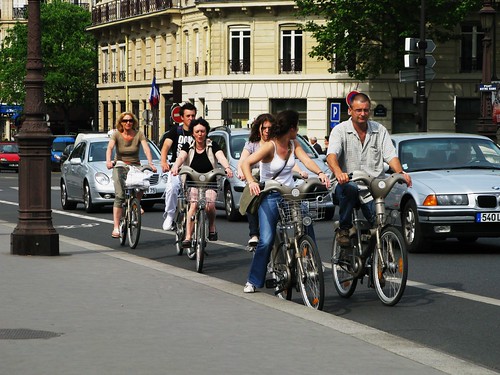
I've driven in most American states and Canadian provinces, every Australian city and 20 odd countries around Europe. And I've driven in Paris many a time. This witches cauldron of automotive hell is second only to Roma on the stress and chaos level, in my experience. The life-size bumper car ride that is Paris makes New York look like a parking lot.
How on earth would such a chaotic city deal with this sudden and drastic change?
Amazingly... with ease. The cyclists of Paris are everywhere, on every street and at all hours, and yet the cars and trucks have adapted to them. In the space of 10 short months. The first thing we noticed was that everyone rides. Men and women, young and old. And the fact that so many women ride - easily 50% - is a telltale sign that there is a karmic co-existence in play.
We spent the first day doing things we usually do in Paris, all the while watching the cyclists. Dapper old chaps, chic jeunes femmes, kids and parents - they all moved effortlessly through the traffic. There was no fear to be seen and that fact was what helped Wifealiciousness hop on a Vélib on the second day.
The greatest hurdle to implementing bike culture on a city without it is this co-existence between cars and cyclists. Paris sussed it out in no time. Turning cars stop for bikes continuing straight on. The cyclists are watchful and attentive. And this is PARIS! It's the greatest hurdle because you can't expect it to happen. You can't force it upon people. But Parisians have accepted it without question.
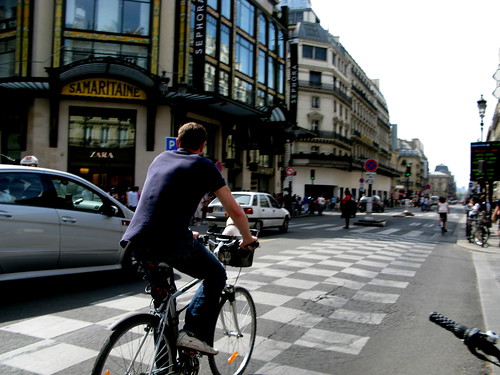
The City of Paris has done their homework, too. If you want bike culture, you need segregated bike infrastructure for the bikes. By and large, the bikes follow the existing bus lanes. Busses in Paris stop frequently so you can usually stay ahead of them, but when they overtake cyclists they do so cautiously and slowly. Taxis are also allowed to use the lanes but they, too, excercise caution.
I asked Wifealiciousness if she, at any point, felt scared after two days [and one late night] on the streets. Not at all.
Apart from the bus lanes - now bus/bike lanes - there are many places that have segregated and dedicated bike lanes. This is, of course, the key to developing bike culture. If there was a book called Bike Culture for Dummies, this would be on the first page.
We rode along the Seine late Saturday night on dedicated bike lanes, all the way from Pont Neuf to the Eiffel Tower. What a glorious ride.
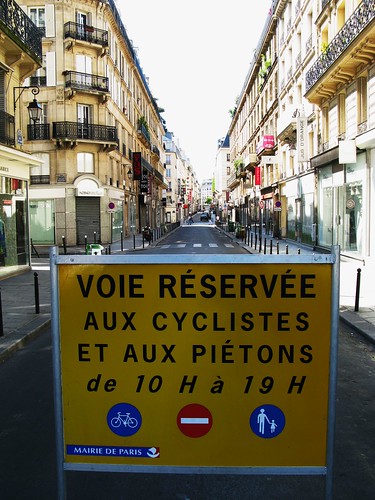
On Sundays, that great European Sunday pasttime - the promenade - is a treat in Paris. The road along the Seine is closed to cars from 9-17 and many streets throughout the city are closed, like in the photo above.
Give the citizens a day of total freedom and they'll feel even more free on the other six days on the bike lanes.
There are so many excuses as to why implementing bike culture is so difficut in cities/countries without it. Excessive car traffic, car-based culture, lack of awareness about bikes in the traffic, implementing bike infrastructure, etc.
In the course of 10 months, Paris has basically proved them all wrong. If you build it, they will come.
Click for a larger picture.
Fakta om cykelhjelm
Fakta om sykkelhjelm
Fakta om cykelhjälm
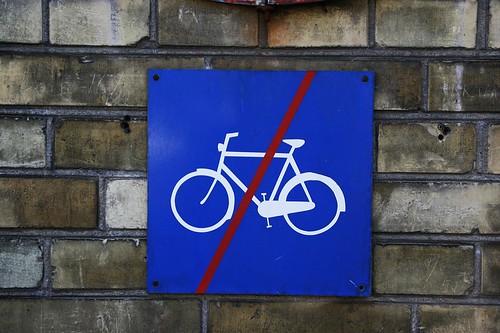
A country's bike culture is reflected in its bike signs. Fenders, chainguard, proper dynamo light. If the pictogram featured a 10 speed you'd think that no racing was allowed. But with this sign you're sure it means the general population.
This sign is at the entrance to a hospital where ambulances arrive. You just have to walk your bike for five metres or so before hopping on again.

I love the man's smile as he watches the two young kids ride past. Sums up the simple pleasure of cycling in Copenhagen.
I read an article the other day about how the sale of Bio-hybrid cars is booming in Sweden. There has been an increase of 103%, since April 2007, in sales of cars that run on more environmentally-friendly petrol.
The Swedish government offers an 8000 kroner discount if you buy one of the cars, so that has probably helped boost sales.
The most popular models are the SAAB 9-3 Biopower, Volvo V70 Flexifuel and V50 Flexifuel.
I read alot about this oil crisis in America and I recall a statistic about how more bicycles were sold in America in 1976 than cars because of the oil crisis back then. Let's hope bike sales increase again now and that people actually ride them.
While oil prices are higher than normal at the moment here in Europe, they are not drastic. The price of oil is pegged to the dollar and since the dollar is so low against the euro, we don't really feel the pinch.
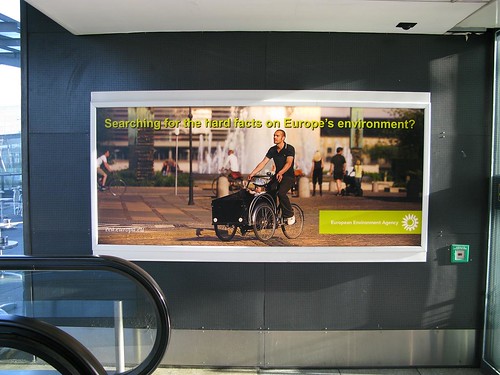
I was interviewed by an Irish journalist the other day about Copenhagen's bike culture and what have you. One of the questions was about government cycling brochures and adverts. In Ireland, he told me, all the photos on such literature feature cyclists with fluorescent vests and helmets.
Here's an advert [above] that I saw at an airport, for the European Environmental Agency. It reflects the bicycling life for millions of Europeans.
The good news regarding Ireland is that urban cycling is up 17% in Dublin since last year, due largely to a new tunnel for heavy vechicles so that they avoid the city centre. Great news!
I met with this lovely chap the other day. Richard from Vancouver. He is involved in bike advocacy on a municipal level and is part of the BC Bike Coalition. He's on a research trip around Europe we hooked up on the city hall square and cycled off for a beer to discuss our segregated bike infrastructure and all manner of things related to bike culture.
Exchanging observations and experiences, stats and numbers. It was a lovely meeting. Richard had, of course, rented a bike for the duration of the journey. If you come to Copenhagen and need a bike, it'll probably end up looking like this one.
Nice to have met you Richard! It was a pleasure.
Bikes make life more beautiful. And bright colours and sunshine don't make it worse.
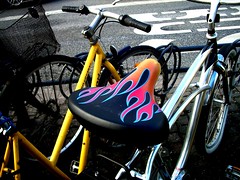
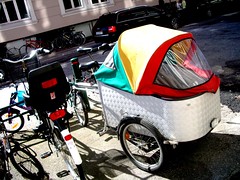
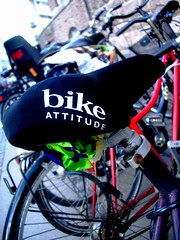
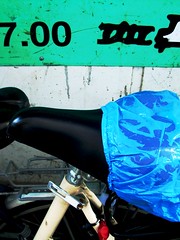

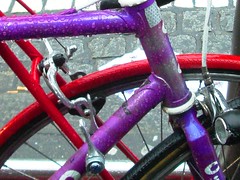
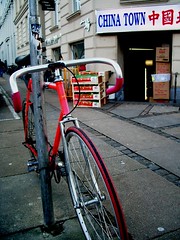
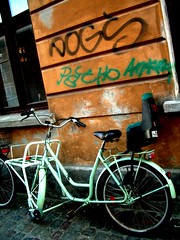
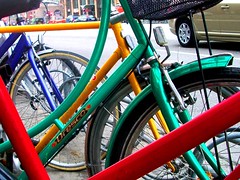
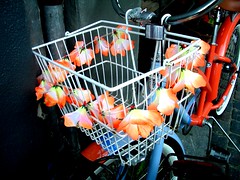
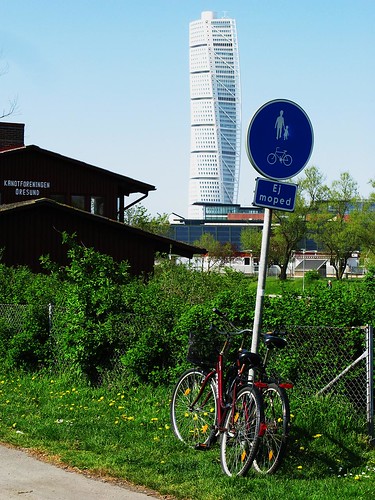
Bike path by the sea, with the famous Turning Torso building in the background.
Malmö is Sweden's third-largest city and one with a bike culture to be proud of.
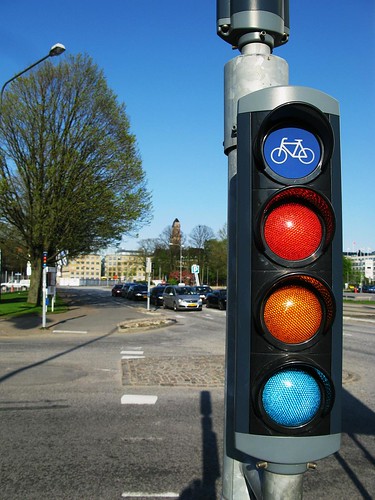
Brand spanking new bike traffic lights in the former docklands area, now a posh residential area and seaside retreat for the citygoers. Nothing quite as lovely as a new traffic light for bikes to accompany a sophisticated system of segregated bike lanes.
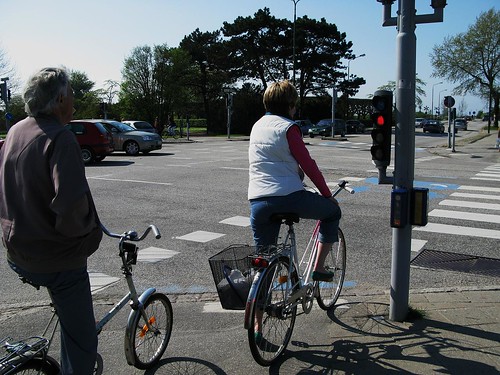
Cyclists waiting on their segregated bike lane for the bike traffic lights to change to green.
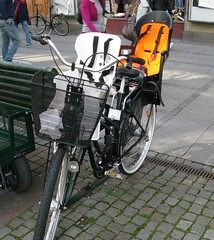
Universal sight in Europe and Japan.
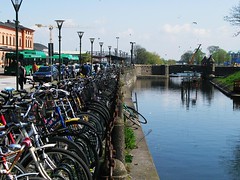
Bike parking outside the Central Station. Another universal sight in Northern Europe, from Stockholm to Berne, Berlin to Amsterdam.

Beautiful chain guard.
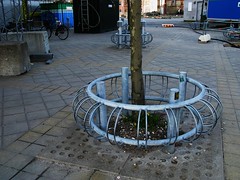
Classic bike racks embracing a tree.

Segregated bike infrastructure. The goal for any true lover of bike culture.
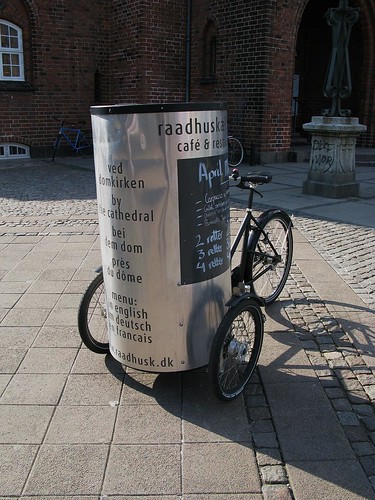
A café in the city of Roskilde uses a Nihola posterbike to advertise. They just park it out on the main square to draw attention to themselves.
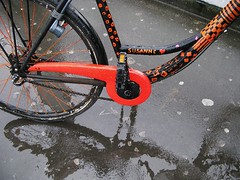
A lovely example of personlising your bicycle. Susanne, whoever she is, swung her paintbrush with love and affection. She parked her bike outside Valby Station.
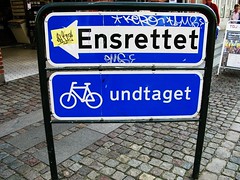
Classic sign, seen all over the nation. This one is in the city of Roskilde.
"One Way Street - Bicycles Excepted"




